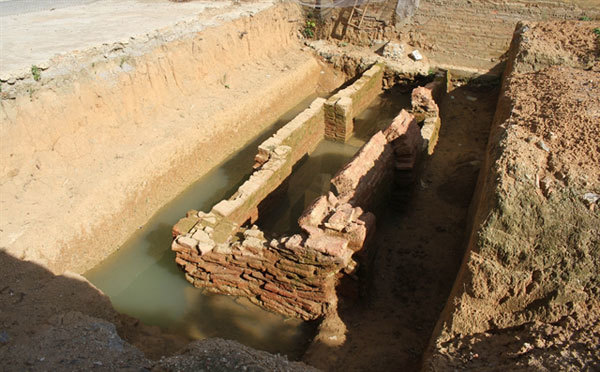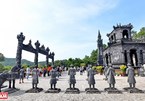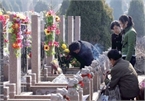 |
| A tomb unearthed in Gia Thuy Primary School in Ninh Binh. VNA/VNS Photo Thuy Dung |
Dinh Van Duc, deputy chairman of Xuan Thuy Commune’s People’s Committee in Nho Quan District, confirmed the traces found at Gia Thuy Primary School.
He said a tomb has been excavated while three others will be unearthed in mid-July when pupils go on summer holiday.
Earlier this year, when construction work was started in the school, workers unearthed a brick construction, which was thought to be an ancient tomb.
The Local Culture and Sports Department then issued a decision to conduct an urgent excavation. Experts from the provincial museum and the Vietnam Archaeology Institute and Historical Science Institute worked at the site and discovered three more places in the area with traces of brick tombs.
The excavation revealed the whole structure of the first rectangular tomb. It has a curved roof and is located in a north-south direction with a total length of 7.4m and width of 2.15m. The wall of the tomb is 0.58m thick.
Various objects found buried in the tomb including bronze items, baked clay plates, ceramic ware, a bronze mirror and beads of gold and gems.
The bronze mirror was decorated with three animals like that in Chinese culture, together with a bird like Chim Lac carved on Dong Son drum of Vietnamese culture.
Nguyen Xuan Khang, director of Ninh Binh Museum, said experts assumed that the tomb was built in the third century BC.
The tombs provide evidences of a residential area in the region of early Vietnamese people.
Data from the tombs will be then used for further research on brick tombs in the province and around the country.
The experts suggested to move the tombs to the museum for exhibition. VNS

The imperial tomb of Khai Dinh
Built in 1920 and finished in 1931, Khai Dinh tomb is one of the most unique architectural features of the royal art in Hue city. It is the resting place of the 12th Emperor of Nguyen Dynasty – Khai Dinh (1885 – 1925).

Vietnamese preserve tomb-sweeping tradition
Vietnamese families often visit their ancestors’ tombs and clean gravesites whenever the Lunar New Year (Tet) comes, normally from the 23rd of the last month of the lunar year to New Year’s Eve.
 Archaeologists have discovered four places with traces of ancient brick tombs at a local school in the northern province of Ninh Binh, according to local authorities.
Archaeologists have discovered four places with traces of ancient brick tombs at a local school in the northern province of Ninh Binh, according to local authorities.